Books & Culture
Flannery O’Connor: A Reading Primer

When I was in grad school, we read and attempted to discuss Flannery O’Connor’s story “Greenleaf,” about a prideful and piteous farm-owner who gets gored by her farmhand’s bull, in one of my craft seminars. The process was a little awkward. Not because we didn’t like it — everyone thought that the story was brilliant — and not because we couldn’t find a way in, but rather, we were overwhelmed. It was, on the one hand, too nuanced, too smart, too minutely calibrated; it may’ve seemed to us a shame to go digging around in its beautiful guts. On the other, however, it was enigmatic. Apart from a couple ungainly bear-swats at class and Catholic symbolism, we couldn’t seem to pin it down.
As the Misfit from “A Good Man is Hard to Find” says of the reason he was sent up to the penitentiary, “Oncet in a while, I would think it was coming to me, but it never came.”
The predominant impulse was just to admire it.
Looking back, this made some sense. O’Connor is nothing if not overwhelming.
In her genius, that’s a given. But also her theology, her violence, her precision. Her cartooning and lampooning. Her characters’ terrible, wonderful fates. Her philosophical density. Her incisiveness of style. Her existential mystery and her earthy everydayness. The prescience of her essays. Her epistolary output. Her American-ness tempered by her bizarreness, the near certainty she was not of this earth, as though she’d emerged from a Georgia crop-circle, been adopted by Catholics, taught mere mortal ways. The thirty-nine years that she lived in this world — far too brilliant, far too short.
All of this is compounded, of course, if you’ve never read her before. And so in honor of FSG Classics’ 2015 reissue of the work of the greatest American writer ever to load up a typewriter, IMO, I’ve attempted to devise an O’Connor crash-course for the uninitiated and a reminder to those who are already converts. The books are recommended as they might be best read, all at once over several dark months of the soul.
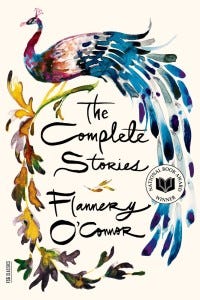
A Good Man is Hard to Find and Other Stories (1955)
A scorching introduction to O’Connor, to be sure. Immerse yourself first and then dress your wounds later. Though they can also be found in The Complete Stories, the stories in A Good Man is Hard to Find are some of O’Connor’s first, not to mention her most anthologized. They are also some of her hardest and most unwavering, filled with all manner of casual violence and cruelty, the relentless critique of genteel Southern living, humor so dark you can barely see through it, razor-wire dramatic tension, masterful sketch characterizations and more. Many of the stories venture upon what would become one of O’Connor’s predominant career-long themes: the manifestation of “Grace” in the world; how it changes our lives, often in the form of violent catastrophe and how, in O’Connor’s own words, “change [can be] painful.” Much like the early work, say, of Cormac McCarthy (Child of God, Suttree) who himself owes a colossal debt to O’Connor, or even that of Shakespeare (Titus Andronichus) — O’Connor’s genius can step to the Bard’s — the stories exhibit the mark of a writer rambunctiously entering into her power. In “A Good Man is Hard to Find,” perhaps O’Connor’s most famous story, a middle-class family on a car-trip en route to Florida is confronted by a nihilistic killer who sees himself as the savior of mankind. While in “Good Country People,” a crippled PhD of Philosophy forges an unlikely connection with an itinerant Bible salesman with a prosthetic limb fetish who may or may not be the Antichrist. Cringe and cower. Then rejoice.
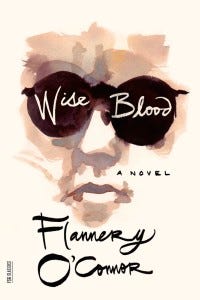
Wise Blood (1952)
Perhaps the most consummately bizarre of O’Connor’s fiction, this first novel takes its bearings in the wild, hallucinatory multiverse of manic street-preachers and self-made prophets in post-WWII Tennessee. O’Connor wrote early drafts of the novel by way of a series of shorts she produced while in residence at the Iowa Writer’s Workshop in 1946. The novel is notably hard to describe: Hazel Motes, a veteran of WWII, out of which he emerges on a government pension after suffering ambiguous war-wounds, returns to his childhood home in rural Tennessee only to find it forsaken. In a lather of spiritual torment, he boards a train for Taulkinham, where he falls in with a prostitute, a disturbed adolescent zookeeper and a father-and-daughter pair of street revivalists, who plunge him into a Christ-haunted descent into madness. Like much of O’Connor’s early work, Wise Blood is also incredibly funny, a kind of twisted picaresque. The zookeeper kidnaps a mummified dwarf, which he donates to Hazel; he later destroys it. An ape-costume serves as a prophet of faith. Spoiler alert: things don’t end well for Hazel. The book is, finally, melancholy, as is the reader to finally leave it. Like the best mid-20th-century Southern fiction (A Confederacy of Dunces, The Moviegoer, Reflections in a Golden Eye), churning with incident, bleak lyricism and the profane desires of its scheming grotesques, Wise Blood tickles, sears and haunts, and the world seems a little less bright once you leave it. It shouldn’t work, but does it ever.
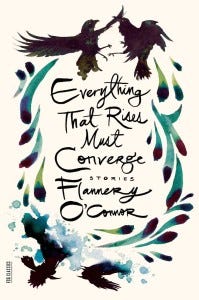
Everything That Rises Must Converge (1965)
Chronologically the last book that O’Connor produced before her death from lupus in 1964 (the book was published posthumously), Everything That Rises Must Converge, a story collection, shows something akin to O’Connor’s soft side, though even that seems like a stretch. The stories in Everything Rises… are more domestic, more contemplative and in some ways more merciful than those in A Good Man is Hard to Find, though no less intense in their dissection of race relations, class tension, regional hypocrisy and spiritual accountability. They’re magnanimous stories — in terms of their word count, but also in terms of their characters’ lots; how “grace” compels them through the world. In the title story, a young typewriter salesman-cum-wannabe-writer who fancies himself a progressive boards a newly integrated city bus with his infirm, racist mother blind to the fact that by the time they arrive at their destination, the mother’s “reducing class” at the Y, they will find themselves sainted by earthly travail. In “Parker’s Back,” one of my favorite of O’Connor’s stories, a tattooed handyman named Obadiah Elihu marries an evangelist teetotaler whose tacit resentment drives him to cover his back with a gory Byzantine portrait of Christ. The stories in Everything That Rises… bear the mark of a more mature O’Connor. Instead of denying her characters their body parts or their lives as she does in A Good Man…, she denies them morality, comfort, compassion. People can decide to change, but all too often stay the same. As Mrs. Turpin observes just before her ecstatic vision at the end of “Revelation,” “There was only a purple streak in the sky, cutting through a field of crimson and leading, like an extension of the highway, into the descending dusk. [Mrs. Turpin] raised her hands from the side of the [pig] pen in a gesture hieratic and profound. A visionary light settled in her eyes.” Everything That Rises is the dusk before the dark, the sorrow of the day’s undoing.
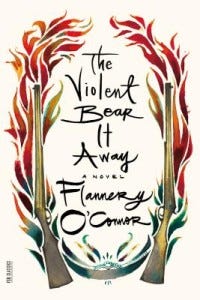
The Violent Bear It Away (1960)
O’Connor’s second and final novel, written in between her story collections and taking its name from a passage in Matthew, situates us on a middle ground between horror and heartbreak, reaping and rapture. It also has one of the most compelling and controlled long-sentence openings in literature: “Francis Marion Tarwater’s uncle had been dead for only half a day when the boy got too drunk to finish digging his grave and a Negro named Buford Munson, who had come to get a jug filled, had to finish it and drag the body from the breakfast table where it was still sitting and bury it in a decent and Christian way, with the sign of its Saviour at the head of the grave and enough dirt on top to keep the dogs from digging it up.” This was the book that first fired me up on O’Connor and I maintain its brilliance fiercely, though often it’s lost to the shine of the stories and Wise Blood’s heedless gonzo glee. The plot of the novel follows the dark enlightenment of Tarwater who, after finding his first uncle dead, burns the house down with him in it and flees only to fetch up on the doorstep of his other uncle, Rayber, a schoolteacher, and his mentally handicapped son, Bishop, who repulses Tarwater as somehow sub-human. Tarwater, who had been ordained a “prophet” by the mad evangelical uncle whose body he abandoned in the burning house, must choose between fulfilling his destiny as an instrument of God and following the rational path of Rayber while Bishop, poor Bishop, is caught in the crossfire. Let’s just say the choice he makes mirrors just what we’ve come to expect from O’Connor. I can still remember the last 50 pages or so of The Violent Bear It Away as some of the most continually disturbing and unexpected writing I’ve ever encountered in a novel — and that’s fifteen years out from the first time I read it. The novel is a revelation: Tarwater’s, surely, but also the reader’s. Try to bear witness without going blind.
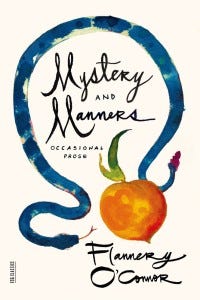
Mystery & Manners: Occasional Prose (1969)
Mystery & Manners, edited by O’Connor’s besties Robert and Sally Fitzgerald and published 5 years after her death, compiles O’Connor’s career-long meditations on peacocks, fiction-writing and Catholicism, all of it touched by a life lived in Dixie. The essays are a fitting capstone to O’Connor’s fiction for several reasons: 1. They serve as a welcome comedown from the brain-hemorrhaging intensity of O’Connor’s novels and stories — a contemplative moment in which to exhale. 2. They shed light on O’Connor’s philosophically various works by situating them in the context of her omnivorous scholarly passions and interests, which makes for many a-ha moments. And 3. Almost like director’s commentary on a limited edition DVD, Mystery & Manners explicates the body of O’Connor’s lifelong work but never with a blowhard vibe; O’Connor’s voice is always present: authoritative, witty, sharp. Indeed, critic Saul Maloff wrote of the essays: “…in each [piece] — how rare this is in expository prose — there is audible always the sound of her voice speaking; never the sound of a machine clattering.” These essays humanize O’Connor, escorting her down from her prodigy’s tower. They show bits of her life — “The King of the Birds,” “The Catholic Novelist in the Protestant South” — and rare insights into her work — “Some Aspects of the Grotesque in Southern Fiction,” “On Her Own Work.” Mostly, though, they show her mind; it is singular, idiosyncratic, complex. In “The King of the Birds,” perhaps the most famous of O’Connor’s essays on the raising of peacocks on her Georgia family farm, she writes: “Analyzing the appearance of the peacock as he stands with his tail folded, I find the parts incommensurate with the whole.” So, too, seems the case with O’Connor herself, as it was with her story “Greenleaf” in that class. You think you’ve got her fiction pat when, suddenly, it fans its tail.
Supplementary Reading By, About, That Influenced or Was Influenced By O’Connor
A Habit of Being: Letters of Flannery O’Connor (1988) by Flannery O’Connor
A Prayer Journal (2013) by Flannery O’Connor
Flannery O’Connor: The Cartoons by Flannery O’Connor & Kelly Gerald (2012)
The Life You Save May Be Your Own: An American Pilgrimage by Paul Elle (2004)
Flannery: A Life of Flannery O’Connor by Brad Gooch (2010)
Miss Lonelyhearts by Nathaniel West (1933)
Absalom, Absalom! by William Faulkner (1936)
The Sundial by Shirley Jackson (1958)
The Lottery and Other Stories by Shirley Jackson (2004)
Child of God by Cormac McCarthy (1973)
Suttree by Cormac McCarthy (1979)
I Hate to See That Evening Sun Go Down by William Gay (2003)
St. Lucy’s Home for Girls Raised by Wolves by Karen Russell (2007)
From the Darkness Right Under Our Feet by Patrick Michael Finn (2011)
The Devil All the Time by Donald Ray Pollock (2012)
Battleborn by Claire Vaye Watkins (2013)
Praying Drunk by Kyle Minor (2014)
Eileen by Ottessa Mosfegh (2015)









